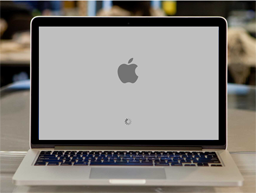Goodbye, Hackintosh
 A number of unpleasant moments associated with the malfunction of my Mac computer forced me to write this post. After the planned Maverick system update my Macbook has failed to boot. Gray screen with Apple logo and load indicator and nothing more. I thought I would never run into this problem again since hakintosh times has passed away long ago. For a while I was very depressed and could not realize the reality. I instantly remembered about the verbal boot mode (Cmd-V when power on). I’ve launched the Mac in this verbose-mode and that’s what I’ve seen at the end:
A number of unpleasant moments associated with the malfunction of my Mac computer forced me to write this post. After the planned Maverick system update my Macbook has failed to boot. Gray screen with Apple logo and load indicator and nothing more. I thought I would never run into this problem again since hakintosh times has passed away long ago. For a while I was very depressed and could not realize the reality. I instantly remembered about the verbal boot mode (Cmd-V when power on). I’ve launched the Mac in this verbose-mode and that’s what I’ve seen at the end:
SMC::smcReadKeyAction ERROR: kSMCReadKeyComm/kSMCReadKeyWithSMCComm failed for key REV (kSMCSuccess)
All that Google gave was leading me to the resources associated with the hakintosh, so I did not even paid an attention to them, because I could not imagine that the genuine Mac (which I currently had) might be connected with Hackintosh. I was wrong – the answer was exactly in Hachintosh. But I did not listen to my intuition and just proceeded investigation which taught me a lot of interesting and useful. For instance, in Mac’s BIOS there is a diagnostic program which you can use to check all of the devices as well as hard drive. In addition, the hard drive has a recovery partition, it is possible to start the installation of Mac OS from blank list, as well as to run Disk Utility, that lets you scan and heal the file permissions – widespread reason of inability to boot the system. Also, beginning from OS X Lion you can run the Internet Recovery procedure from a boot menu. There is a safe mode (you should hold the Shift key when turning on the computer), I did not understand, what is its essence, but it did not help me – loading system still has not been reaching the completion.
A bit later I’ve tired to dig further so I’ve decided to make one extreme step. I’ve found an old external hard drive on which six months ago I’ve made the TimeMachine image. After some hesitation, I’ve launched a recovery procedure. I had to accept the loss of some data, since most of them are stored in the cloud. Recovery launches by calling the recovery menu (hold down the Alt key while turning on your computer)
Restore worked for me – the system started up, but however, it’s rolled back from Maverick to the original Mountain Lion.
Right after that I’ve launched the installation of Maverick. Apparently, the current build contains the same service pack, because after the successful installation of the former Maverick back problem – the system was unable to boot. I had started to feel approaching depression, but while I’ve been looking at boot log line
SMC::smcReadKeyAction ERROR: kSMCReadKeyComm/kSMCReadKeyWithSMCComm failed for key REV (kSMCSuccess)
a ghost thought has born inside my mind: hackintosh never gone away!
The point is that I set up all my Macs after the Hackintosh using Migration Assistant – a standard Mac OS X utility, which transfers data from one computer to another. My journey to the world of Mac began with OS X 10.5 Leopard, and as I said it was hackintosh. One of the distinguishing features of those days was hackintosh kext FakeSMC.kext – it was required to simulate a specific OS X SMC (System Management Controller) which is not presented on Windows based PC. After verifying the relevant directory it’s become clear that this Kext permanently migrated from one Mac to the another and was the reason of many other problems as I can see now. For example, my Macs were unable to physically reboot (soft reset) or shut down the power. I had to hold power button each time and that caused the message ‘the system has been switched off due to emergency’ and offer to send a report to Apple when system launched next time. I even sent a couple of times these reports and asked the question on the support forum – I feel very ashamed today).
Removing these kexts helped. One must make sure there is no more /Extra folder on hard drive and also delete /System/Library/Extensions/FakeSMC.kext
Just in case I’ve moved the folder instead of delete
$ sudo mv /Extra /Users/heximal/root_stuff/ $ sudo mv /System/Library/Extensions/FakeSMC.kext/ /Users/heximal/root_stuff/
As a result now all my Macs restart and shut down normally and the update has been successfully installed.
P.S. Now I’m definitely going to make backup images more frequently that once per half of year.

Папка /Extra не страшна, если загрузчик – родной, маковский, а не Хамелеон. Только Хамелеон оттуда подцепляет кексты.
А про FakeSMC – забавно )
Кстати, если на хакинтоше заводили звук, или видеокарту, то могли еще какие-нибудь кексты остаться, HDAEnabler1.kext, к примеру…
Спасибо за комментарий, надеюсь, он кому-нибудь когда-нибудь поможет, как и сама статья)
Я тоже был обеспокоен тем, что помимо FakeSMC могло что-то еще остаться, поэтому сравнил содержимое папки /System/Library/Extenstions на эталонном маке (у коллеги в офисе) со своим. Лишним оказался только пресловутый FakeSMC))
Кстати, про AirPort Time Capsule: мы на работе выбрали NAS от Synology – более гибкие настройки, можно настроить RAID 1.
По теме “real mac” – долго со Славой думали о mac mini, и остановились все-таки на хаке… )
Ба, знакомые все лица, не узнал вас в гриме))
Ничего себе у вас там нечеловеческие эксперименты творятся)
Надо бы заскочить к вам на огонек.
))
Ага, забегай, будем рады )